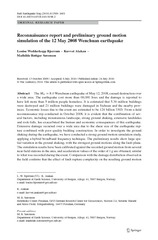Reconnaissance report and preliminary ground motion simulation of the 12 May 2008 Wenchuan earthquake
Peer reviewed, Journal article
Published version
Date
2010Metadata
Show full item recordCollections
- Department of Earth Science [1050]
Original version
https://doi.org/10.1007/s10518-010-9198-2Abstract
The Mw = 8.0Wenchuan earthquake of May 12, 2008, caused destruction over a wide area. The earthquake cost more than 69,000 lives and the damage is reported to have left more than 5 million people homeless. It is estimated that 5.36 million buildings were destroyed and 21 million buildings were damaged in Sichuan and the nearby provinces. Economic losses due to the event are estimated to be 124 billion USD. From a field reconnaissance trip conducted in October 2008, it is evident that the combination of several factors, including mountainous landscape, strong ground shaking, extensive landslides and rock-falls, has exacerbated the human and economic consequences of this earthquake. Extensive damage occurred over a wide area due to the shear size of the earthquake rupture combined with poor quality building construction. In order to investigate the ground shaking during the earthquake, we have conducted a strong ground motion simulation study, applying a hybrid broadband frequency technique. The preliminary results show large spatial variation in the ground shaking, with the strongest ground motions along the fault plane. The simulation results have been calibrated against the recorded ground motion from several near-field stations in the area, and acceleration values of the order of 1 g are obtained, similar to what was recorded during the event. Comparison with the damage distribution observed in the field confirms that the effect of fault rupture complexity on the resulting ground motion
Publisher
SpringerCopyright
The Author(s) 2010Copyright The Author(s) 2010. This article is published with open access at Springerlink.com

